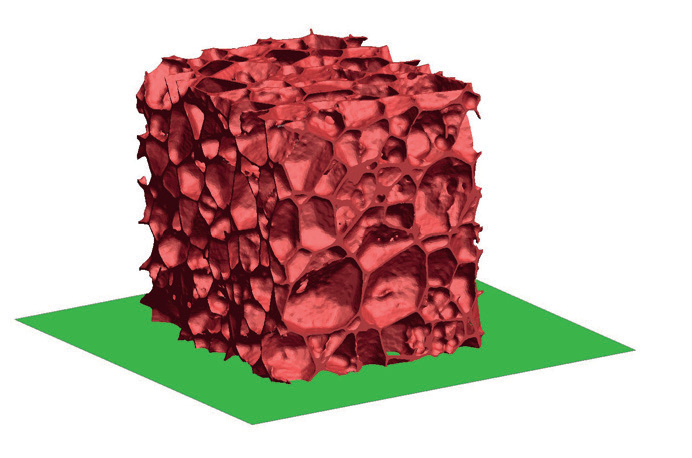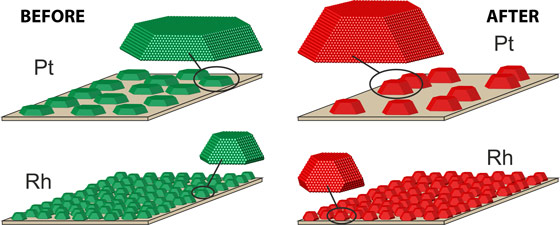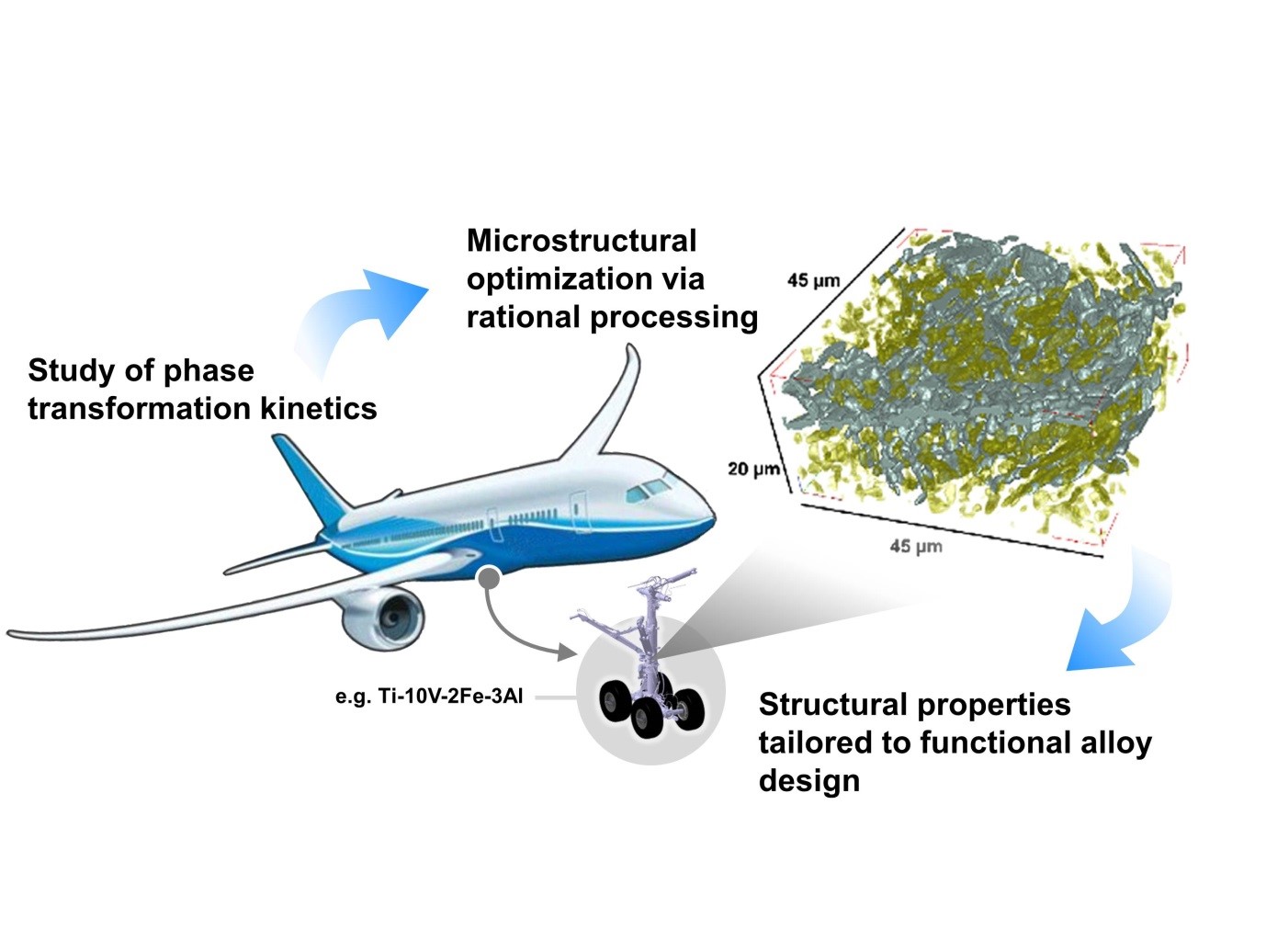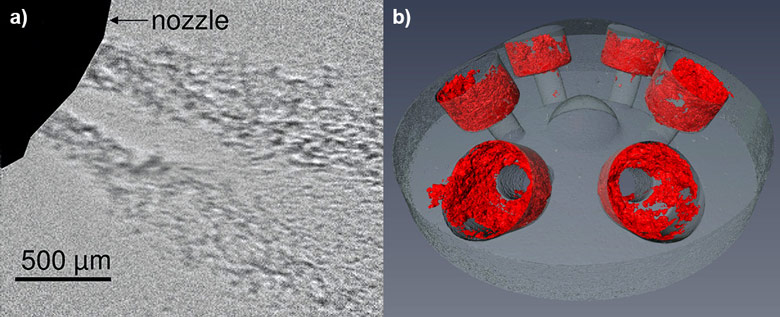- Home
- Industry
- Applications and case studies
- Aerospace and Automotive
Aerospace and Automotive
In the last decades, aerospace industry has evolved dramatically. Research has allowed manufacturers to use new materials and improve the lifetime of airplanes. Understanding how materials behave at extreme conditions helps aerospace industry to assess the capabilities and limitations of aircrafts. Through non-destructive analysis, the ESRF can investigate the changes that materials undergo and correlate a material’s micro- and nanostructure with its properties. Read more
The high energy of the ESRF X-rays penetrates deeply in large structures typically found in aeroplanes, for example. The techniques most widely used in this industry are X-ray diffraction, X-ray fluorescence microscopy, X-ray Absorption Spectroscopy and X-ray powder diffraction. The new ID15 beamline will increase the capabilities of research in the aerospace field because…
- Characterisation of composite materials and advanced alloys.
- Metal foams.
- Study of materials under stress and conduction of fatigue tests.
- Stress distribution by a function of depth in materials.
- Speciation of metallic coatings.
- Analysis of the performance of corrosion resistant coatings.
- Compressive stress profiling.
- Analysis of trace elements in petroleum and petrochemical products
- Characterisation of fuel cells and hydrogen-storage media
- Combustion processes.
- Following the catalysis process in situ.
CASE STUDIES
Company or institute
University College London and Rolls-Royce Plc.
Challenge
Additive manufacture permits rapid fabrication of objects with complex shapes through the layer by layer addition of raw materials and melting with a laser. Compared to traditional manufacture, it has the drawback of lower quality because of inconsistency between objects in a series, in particular due to porosity and spatter caused by the laser interaction with the material.
The keyhole mode of laser melting involves multiple impacts of the laser on the melt at a particular point and is very complex. The challenge of the present research was to reveal the interaction of laser and powder bed in keyhole-mode laser powder bed fusion and to study the melt pool dynamics with the aim to understand its relation to porosity and spatter.
Sample
The sample consisted of the alloy Ti-6Al-4V commonly used for aerospace and biomedical applications. The powder median diameter was 45 μm, size range 5-70 μm, and additive layers were 100 μm.
Solution
An operando experiment was carried out at beamline ID19 combining a laser additive manufacture process replicator with ultra-fast synchrotron X-ray imaging. The setup used a camera running at 40,000 frames a second that permitted an exposure time of 12.5 microseconds and a resolution of about 5 μm per pixel.
Benefits
Ultra-fast high-energy X-ray radiography made it possible to record the transient melt pool dynamics associated with keyhole mode additive manufacture: initiation, development, and melt pool recovery. The studies also provided details of porosity and droplet spatter. The results can be used to guide reduction in porosity and spatter in additive manufacturing. Ben Saunders, Team Leader at Rolls-Royce for Materials and Process Modelling, explained why they are collaborating in the project: “Additive Manufacturing, although simple in principle, is actually an incredibly complex process where the solidification and subsequent multiple heating cycles interact with phase transformations and residual stress. From an industrial standpoint we need to have a deep mechanistic understanding of both the manufacturing process and what the relationship between process parameters and the durability of the parts in service. In situ synchrotron studies are helping us to develop the mechanistic understanding of these relationships, which are simply not observable in any other way, and also provide invaluable data for validating physics-based simulations which allow us to scale up this understanding to industrially relevant problems.” This quote was taken from an ESRF news item that described the experiment: Taking additive manufacturing’s heart beat #weekendusers.
Reference
Synchrotron imaging of keyhole mode multi-layer laser powder bed fusion additive manufacturing, Y. Chen, S.J. Clark, C-L.A. Leung, L. Sinclair, S. Marussi, M.P. Olbinado, E. Boller, A. Rack, I. Todd, P.D. Lee, Applied Materials Today (2020); DOI: 10.1016/j.apmt.2020.100650.
CompanyJaguar Land Rover and University of Warwick ChallengeEnergy absorption is important for the safety of car passengers. Besides the seat foam used for comfort, modern vehicles have a denser foam such as expanded polypropylene (EPP) inside headrests and bumpers that decelerates passengers in such a way as to minimise any stresses on them. Ideally, a foam would do this by deforming in a controlled manner, reducing the maximum forces experienced by the occupant. SolutionThe researchers studied EPP’s energy-absorption properties under deformation at the ESRF, using new material models to improve a computer-aided design process. At the beamline ID19, the researchers performed microtomography, which enabled them to continually image their EPP foams (see figure above) as they were slowly compressed with a dedicated press facility. Incorporating the images into a three-dimensional computer model, the researchers could analyse them to understand how to improve the foam, and how much of it to use in a vehicle for optimal performance. BenefitThe benefit of the ESRF in this research was the ability to track the deformation in situ an in great detail. “The facilities available at the ESRF will allow us to improve the use of polymer foams as energy absorbers in our vehicle range”, expalins Mark Blagdon, a materials engineer who led the project from Jaguar Land Rover. |
|
CompanyUniversity of Hamburg, University of Siegen, DESY, MAXIV ChallengeCatalysts in a car contain noble metal nanoparticles consisting of rhodium, platinum and palladium and alloys thereof. These make the harmful molecules produced by the motor react on the surface of the converter while reaching high temperatures and reducing and oxidising atmospheres. When catalysts operate, the particle size of the noble metals increases. It is a process called sintering, which results in a decrease of the overall catalyst surface area. In the long run, this reduces the number of active sites from the surface and makes the catalyst less efficient. SampleThe sample consisted of stripes of platinum-rhodium nanoparticles with varying composition from pure platinum to pure rhodium and a constant height. SolutionSynchrotron radiation makes it possible to carry out operando experiments where scientists can monitor nanomaterials while the catalytic reaction takes place under realistic thermal and process conditions. The team used high-energy grazing incidence X-ray diffraction and online mass spectrometry. BenefitsThe experiments focused on the behaviour of the alloy nanoparticles during catalytic oxidation of carbon monoxide to carbon dioxide at a temperature of 550 K and near-atmospheric pressures. The results showed that platinum particles increase in height and lead to a reduction of the total particle surface coverage. This did not happen so much with the rhodium and rhodium-rich particles, which indicates that rhodium might be an important ingredient for catalyst stabilization.
|
|
CompanyVienna University of Technology (TU WIEN), German Aerospace Center (DLR) ChallengeThe transportation sector moves towards greater energy efficiency in all areas (i.e. from component production over to fuel consumption) in order to meet the latest performance and environmental targets. The success and progress fulfilling these goals is highly dependent on the availability of new engineering materials and manufacturing methods that enable significant weight savings associated with simultaneous improvements in component performance. Titanium alloys exhibit higher specific strength than other structural materials as well as excellent corrosion and creep resistance up to about 500 °C. These properties represent many performance advantages for the transportation industry. Despite these benefits and the relatively large resource reserves (titanium is the fourth most abundant metal in the earth’s crust), titanium alloys still come at high production costs that limit their industrial usage. Titanium-based components are mainly produced via the classical process of ingot metallurgy (cast and wrought) which provides alloys with high strength levels. At this stage of manufacturing, thermal and thermo-mechanical treatments determine the microstructural characteristics, i.e. the mechanical properties of titanium alloys. On the other hand, selective laser melting (SLM) is a very promising powder-bed based “3D printing” technique that manufactures near net-shape metallic components with higher resource-efficiency than conventional fabrication methods. Consequently, considerable cost savings can be achieved. One of the main key strengths of SLM is that extremely complex geometries inaccessible using conventional manufacturing techniques can be manufactured. In this way, structures of minimal weight and optimized functional performance can be produced. However, the very fast cooling rates reached during solidification of molten metal pools during SLM produce brittle titanium based components with poor mechanical performance. Monitoring the kinetical evolution of the microstructural phases of titanium based components during thermal and thermomechanical treatments would help scientists rationalize their processing either via ingot metallurgy or advanced SLM while improving their mechanical performance (e.g. strength and fatigue resistance). SampleThe a+b Ti-6Al-4V and Ti-6Al-6V-2Sn as well as the metastable b Ti-10Al-2Fe-3Al, Ti-5Al-2Sn-2Zr-4Mo-4Cr, Ti-5Al-5Mo-5V-3Cr-1Zr titanium alloys presenting different initial microstructures. SolutionThe researchers carried out in situ high energy synchrotron X-ray diffraction experiments at the ID15B beamline. Image sequences of complete Debye–Scherrer rings from the bulk of the studied alloys were recorded in transmission mode while heating and cooling the sample within the same temperature ranges used in the industry. This allowed univocal determination of the phase transformations kinetics (i.e. the evolution of the volume fractions and lattice parameters of phases) which confine the microstructural changes of the alloys, i.e. their mechanical properties. Moreover, three-dimensional (3-D) imaging was performed at the ID22NI beamline by high-energy magnified synchrotron tomography using Kirkpatrick–Baez focusing optics, to analyse morphological features of the microstructure (e.g. non-uniform distribution of phases, formation of complex structures, or contiguity between them) and understand their relationship with the mechanical properties of the studied alloys. BenefitsThe studies provide an advance in the current knowledge of the phase transformation kinetics of titanium alloys mostly discussed in the basis of stable conditions (e.g. isothermal aging and ex-situ experiments). This will help to develop new theoretical models for microstructure prediction leading to improvements in functional alloy design, lead-time and cost savings via knowledge-based thermal treatment optimization. Particularly, the results obtained will contribute to overcome the present manufacturing restrictions of SLM manufacturing.
|
Company
Prism Scientific Limited, Wallingford, UK
Challenge
Gasoline direct injection (GDI) systems deliver fuel into the cylinders of an engine. Carbonaceous deposition inside the fluid channels of fuel injectors is a common problem, exacerbated by biogenic fuels now commonly found in the fuel supply. Deposition is problematic since it reduces fuel flow, creates turbulence and makes combustion control more difficult, in a time when regulation of vehicle emissions is making precise control essential. To better understand the effects of carbon deposits in and around the injector spray holes, scientists wanted to visualise the deposits and their effect on fuel injection spray. Fuel injection is a fast phenomenon that takes place in the sub-millisecond timescale. Although ultra-fast light-based techniques have been used, the spray body is impenetrable to them because of light scattering by the droplet field.
Sample
The injectors and fuel used in this study were typical of those available in the market place and realistic operating conditions were employed. Deposits were generated in the injectors using a production engine.
Solution
X-ray cineradiography allows the visualisation of dynamics inside opaque materials by taking advantage of the high brilliance of synchrotron X-ray beams combined with fast X-ray detection. The visualisation of fuel injection was carried out at MHz frame rates at ESRF beamline ID19. When combined with the high-resolution hard X-ray tomographs of the injector with deposit in situ, this creates a powerful diagnostic and modelling tool for study of such problems in real world conditions.
Benefits
Hard X-ray imaging allows visualisation of the inside of dense or multi-scattering objects. Fuel injection was imaged with sufficiently high resolution and frame rate to reveal the internal structures of the spray. The X-ray image contrast achieved for the fuel spray comes from interfaces with different thicknesses and refractive indices.
References
- X-ray cineradiography at MHz frame rates, M.P. Olbinado, X. Just, J.-L. Gelet, P. Hutchins, H. Xu, C. Powell, A. Rack, Imaging & Microscopy, May. 14, 2018 (link).
- Numerical analysis of deposit effect on nozzle flow and spray characteristics of GDI injectors, Bo Wang, Y. Jiang, P. Hutchins, T. Badawy, H. Xu, X. Zhang, A. Rack, P. Tafforeau, Applied Energy 204, 1215-1224 (2017); doi: 10.1016/j.apenergy.2017.03.094.
Company
Airbus
Challenge
High reliability is a critical requirement for the microelectronics used in aircraft, spacecraft and satellites. However, electronic equipment is affected by radiation in the atmosphere and especially in space. Cosmic radiation can lead to corruption of data and even to degradation and failure of devices. This problem is becoming a critical issue with the downsizing of components. Due to the shrink of transistor size, the distance between critical regions has decreased and with it the likelihood of a radiation event affecting two or more bits has increased. Multiple bit upsets cannot be easily corrected by error detection and error correction codes (ECC), which are often effective only for single bit errors. The effect of radiation could be all the more significant for 3D stacked memory, where one radiation incident could perturb many adjacent layers.
Engineers from Airbus have already tested electronic components in cyclotron facilities, under heavy ions. Most of the cyclotrons provide high LET (Linear Energy Transfer) heavy ions not capable of penetrating through a significant thickness of materials. As technology develops, complex chips may contain a stack of active layers that can be very different to each other, and traditional cyclotrons cannot access the buried layers.
X-ray beams can be used to simulate the effects of heavy ions passing through microelectronics. The advantage of synchrotron sources is that X-rays can penetrate through different layers. Airbus wanted to investigate the effect of X-ray irradiation on microelectronics and came to the ESRF for an experiment at beamline ID09. The main objective was to verify whether X-ray beam can trigger single event effects in the deepest die of a stacked device.
Sample
3D stacked memory modules were used in this study.
 |
|
Legend. The 3D stacked memory modules studied at beamline ID09. Credits: ESRF/C. Argoud. |
Solution
The intense X-ray beam at ID09 has a wide frequency range and is able to penetrate deep into objects. The beamline is equipped with a beam chopper for precise control over the duration of irradiation. The chopper can be used to set the dose of radiation for the sample: a 100 picosecond pulse of “pink beam” produces around 1x109 photons.
Benefits
Beamline ID09 was used to scan the die area with a beam size of 60 x 40 µm2. The functioning of the chip and the integrity of its data was continuously checked during irradiation. Several types of single event effects were observed in all stacked layers. Through this experiment, Airbus has validated the use of X-rays to test 3D stacked memories.
Reference
This experiment was partly funded by the DEMETER project, an ECSEL Joint Undertaking, an EU-driven, public-private partnership, funding innovation in electronic components and systems. This experiment should be submitted for a publication in 2019.









